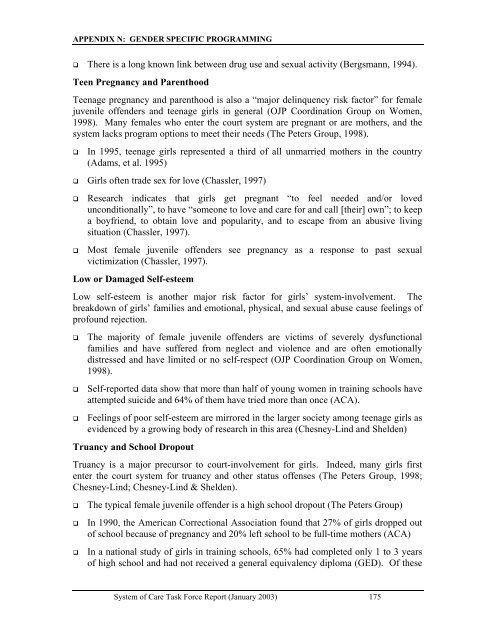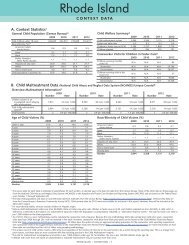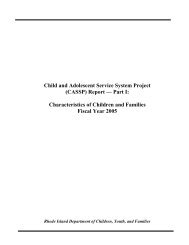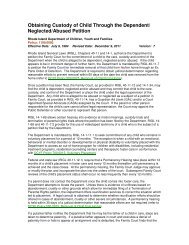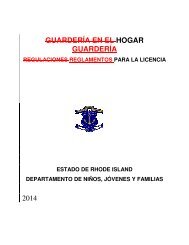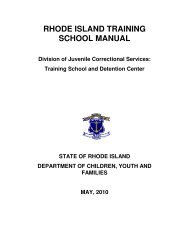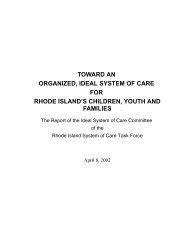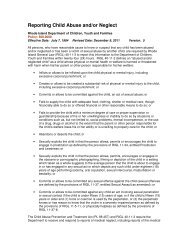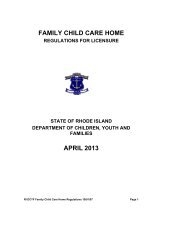Final Report - RI Department of Children, Youth & Families
Final Report - RI Department of Children, Youth & Families
Final Report - RI Department of Children, Youth & Families
You also want an ePaper? Increase the reach of your titles
YUMPU automatically turns print PDFs into web optimized ePapers that Google loves.
APPENDIX N: GENDER SPECIFIC PROGRAMMING<br />
! There is a long known link between drug use and sexual activity (Bergsmann, 1994).<br />
Teen Pregnancy and Parenthood<br />
Teenage pregnancy and parenthood is also a “major delinquency risk factor” for female<br />
juvenile <strong>of</strong>fenders and teenage girls in general (OJP Coordination Group on Women,<br />
1998). Many females who enter the court system are pregnant or are mothers, and the<br />
system lacks program options to meet their needs (The Peters Group, 1998).<br />
! In 1995, teenage girls represented a third <strong>of</strong> all unmarried mothers in the country<br />
(Adams, et al. 1995)<br />
! Girls <strong>of</strong>ten trade sex for love (Chassler, 1997)<br />
! Research indicates that girls get pregnant “to feel needed and/or loved<br />
unconditionally”, to have “someone to love and care for and call [their] own”; to keep<br />
a boyfriend, to obtain love and popularity, and to escape from an abusive living<br />
situation (Chassler, 1997).<br />
! Most female juvenile <strong>of</strong>fenders see pregnancy as a response to past sexual<br />
victimization (Chassler, 1997).<br />
Low or Damaged Self-esteem<br />
Low self-esteem is another major risk factor for girls’ system-involvement. The<br />
breakdown <strong>of</strong> girls’ families and emotional, physical, and sexual abuse cause feelings <strong>of</strong><br />
pr<strong>of</strong>ound rejection.<br />
! The majority <strong>of</strong> female juvenile <strong>of</strong>fenders are victims <strong>of</strong> severely dysfunctional<br />
families and have suffered from neglect and violence and are <strong>of</strong>ten emotionally<br />
distressed and have limited or no self-respect (OJP Coordination Group on Women,<br />
1998).<br />
! Self-reported data show that more than half <strong>of</strong> young women in training schools have<br />
attempted suicide and 64% <strong>of</strong> them have tried more than once (ACA).<br />
! Feelings <strong>of</strong> poor self-esteem are mirrored in the larger society among teenage girls as<br />
evidenced by a growing body <strong>of</strong> research in this area (Chesney-Lind and Shelden)<br />
Truancy and School Dropout<br />
Truancy is a major precursor to court-involvement for girls. Indeed, many girls first<br />
enter the court system for truancy and other status <strong>of</strong>fenses (The Peters Group, 1998;<br />
Chesney-Lind; Chesney-Lind & Shelden).<br />
! The typical female juvenile <strong>of</strong>fender is a high school dropout (The Peters Group)<br />
! In 1990, the American Correctional Association found that 27% <strong>of</strong> girls dropped out<br />
<strong>of</strong> school because <strong>of</strong> pregnancy and 20% left school to be full-time mothers (ACA)<br />
! In a national study <strong>of</strong> girls in training schools, 65% had completed only 1 to 3 years<br />
<strong>of</strong> high school and had not received a general equivalency diploma (GED). Of these<br />
System <strong>of</strong> Care Task Force <strong>Report</strong> (January 2003) 175


